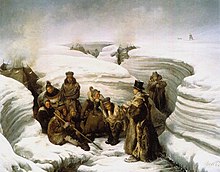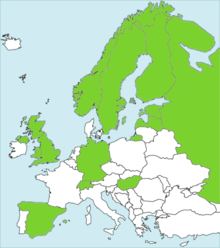You can help expand this article with text translated from the corresponding article in Finnish. (June 2023) Click for important translation instructions.
|
| Part of a series on |
| Laestadianism |
|---|
 |
| History |
| Key people |
| Doctrine |
| Movements |
| Organizations |
| Events |
| Culture |






Conservative Laestadianism is the largest branch of the Lutheran revival movement Laestadianism. It has spread to 16 countries. As of 2012 there were about 115,000 Conservative Laestadians, most of them in Finland, the United States, Norway, and Sweden. The movement and this denomination attribute their teachings to the Bible and the Lutheran Book of Concord.
History
Laestadianism received its name from Pastor Lars Levi Laestadius. The origin of the denomination's name from the Finnish word for 'conservative' (vanhoillis-) is unknown. In North and South America as well as in Africa this denomination is known as the Laestadian Lutheran Movement.
The movement began in Swedish Lapland. Laestadius met a Sami woman named Milla Clementsdotter of Föllinge, during an 1844 inspection tour of Åsele. Clementsdotter recited various biblical teachings to Laestadius. This was an important meeting for Laestadius because afterwards he felt he understood the secret of living faith. He believed that he received the forgiveness for his sins and saw the way that led to the eternal life. His sermons underwent a marked transformation, and the movement began to spread from Sweden to Finland and Norway.
Divisions
At the beginning of the 20th century, Laestadianism broke into three branches: The Firstborn Laestadianism, Reawakening, and Conservative Laestadianism. After this major schism, several other groups have also departed from Conservative Laestadianism. It nevertheless remains the largest branch of Laestadianism.
Dissociation and exclusivity
Conservative Laestadianism's leadership rigidly adheres to the teaching that all other Christian groups, including other Laestadian sub-groups, even those doctrinally identical to Conservative Laestadians, are heretical and have no place in the Kingdom of Heaven.
Doctrine
| This section needs additional citations for verification. Please help improve this article by adding citations to reliable sources in this section. Unsourced material may be challenged and removed. Find sources: "Conservative Laestadianism" – news · newspapers · books · scholar · JSTOR (June 2023) (Learn how and when to remove this message) |
The central teaching of Conservative Laestadianism, like the movement as a whole, is the declaration of forgiveness of sins whereby members proclaim to one another, "You can believe all sins forgiven in Jesus' name and precious blood," or similar words. Upon receiving this rite, a believer is said to receive the Holy Spirit allowing him or her to be saved from eternal damnation on the basis that God forgets all sins when they have been forgiven. This rite is also called the power of the "keys of the kingdom."
Conservative Laestadians believe that God has given the gift of faith to every child born in the world, although in their world view only Conservative Laestadians actually accept the gift.
Conservative Laestadians often have large families due to their belief that contraception is a sin. They believe that God is the lord of birth and death. They do not have a television at home because of the showing of what is viewed as offensive and sinful programing. They do not drink alcohol or listen to pop music. Recently, however, the Internet is blurring the line between television and no television as many watch television programming on the Internet.
Conservative Laestadians have about 780 preachers and 120 priests. LLC has about 68 preachers. All preachers among Conservative Laestadianism are men.
Distribution



Conservative Laestadianism is located mainly in northern Europe and North America. Small congregations can be found in Africa, southern Europe and South America. There are about 115,000 Conservative Laestadians, most of them in Finland, the United States and Sweden. Most (80,000-150,000) are in Finland. Conservative Laestadians organize big summer services every year. It is the biggest religious event in Nordic countries. About 70,000 guests come from all over the world. Conservative Laestadianism does mission work in 16 countries: Ecuador, Estonia, Finland, Germany, Great Britain, Hungary, Canada, Kenya, Latvia, Norway, Russia, Spain, Sweden, Switzerland, Togo and the United States.
Congregations in North America are located in the following provinces and states:
Canada: Alberta, British Columbia, Ontario and Saskatchewan.
United States: Alaska, Arizona, California, Colorado, Connecticut, Florida, Illinois, Michigan, Minnesota, Montana, North Dakota, Oregon, Washington, and Wyoming.
Child sex abuse scandal
In 2011, the Finnish news media reported widespread child sexual abuse and coverup within Finnish Conservative Laestadianism occurring over at least 30 years that eventually led to many criminal cases including against several Laestadian lay preachers, resulting in lengthy prison terms. Child welfare worker Johanna Hurtig, Ph.D., herself a Conservative Laestadian, allegedly uncovered the abuse in the course of her research on sex abuse in the Finnish Lutheran church as a whole. After she was ridiculed and dismissed by the Finnish Conservative Laestadian leadership, Hurtig's findings were reported to the media, leading to wide scrutiny of the sect by the Finnish public.
Criticism of claims
An article by Jani Kaaro from July 2015 entitled "Laestadians – A Modern Witchhunt" in the Finnish publication Rapport, questions the methods used to build the cases against the church leaders by the Finnish criminal justice system, in particular alleging the possible planting of the false ideas in children's minds.
Associations
- North America: Laestadian Lutheran Church (LLC)
- Finland: Central Association of the Finnish Associations of Peace (Suomen Rauhanyhdistysten Keskusyhdistys ry - SRK)
- Sweden and Norway: Central Association of the Swedish Associations of Peace (Sveriges fridsföreningars centralorganisation - SFC)
- Estonia: Estonian Lutheran Association of Peace (Eesti Luterlik Rahuühendus)
Publications
Conservative Laestadians have five newspapers, three in Finland and two in North America. Those newspapers are translated into eight languages. The LLC publishes The Voice of Zion and The Shepherd's Voice in English, Finnish, French and Spanish. The SRK in Finland publishes Päivämies, Siionin Lähetyslehti and Lasten polku (previously Siionin Kevät) in Estonian, Finnish, English, German, Russian and Swedish. The hymnal, Songs and Hymns of Zion, has been translated into seven languages. There is also a book which describes Conservative Laestadian doctrine, The Treasure Hidden in a Field. However, the Bible is their most important book.
Literature
- Treasure Hidden in a Field, ISBN 1-887034-04-8
- From Victory to Victory, SRK
- In the Footsteps of the Sheep, ISBN 1-887034-03-X
- By Faith, LLC
- God Is Love, ISBN 1-887034-01-3
- The Storms Will Cease, ISBN 0-8087-0038-3
- Aviva and the First Christmas, LLC
See also
Sources
- Talonen, Jouko (2001). Iustitia 14, STI-aikakauskirja, Lestadiolaisuuden monet kasvot. Lestadiolaisuuden hajaannukset (PDF). Suomen teologinen instituutti (STI). ISBN 952-9857-11-X. Archived from the original (PDF) on 2021-07-28. Retrieved 2015-03-04.
- Talonen, Jouko (2012). "Lestadiolaisuuden synty, leviäminen ja hajaannukset. Lestadiolaisuuden tutkija, kirkkohistorian professori Jouko Talosen luento. Virtuaalikirkko has videos from seminar, and they are archived in Internet. Laestadiuksen perintö ja perilliset - seminaari Oulussa 4.-5.10.2012 7. lokakuuta 2012". Oulun hiippakunta, Pohjoinen kulttuuri-instituutti and Oulun ev.-lut. seurakunnat. Archived from the original on 2014-04-13.
References
- ^ Talonen 2001. s. 25
- ^ Talonen 2012. Lecture (in finnish) in Laestadius-seminar in Oulu 5. october 2012. Virtuaalikirkko has videos from seminar, and they are archived in Internet: "VIRTUAALIKIRKKO - Virtuaalikirkon arkisto". Archived from the original on 2014-08-05. Retrieved 2012-10-17.
- "An Examination of the Pearl". 2012. p. 84 et seq. Retrieved November 22, 2014.
- Päivämies, 20.12.2006, Puhujien kokous, Page 10
- LLC: Who We Are Archived 2007-02-06 at the Wayback Machine Retrieved on 2007-2-20
- LLC Member Churches Archived 2007-02-06 at the Wayback Machine and Lestadiolaisuus Ecuadorissa Retrieved on 2007-2-20
- ^ SRK: Seurat ulkomailla Archived 2006-03-13 at the Wayback Machine Retrieved on 2007-2-20
- Helsingin sanomien Kuukausiliite Elokuu 2006, Article; Ja täyttäkää maa, Page 52
- SRK:n suviseurat Archived 2007-01-05 at the Wayback Machine Retrieved on 2007-2-20
- Lestadiolaisuus Ecuadorissa Retrieved on 2007-2-20
- ^ LLC Member Churches Archived 2007-02-06 at the Wayback Machine Retrieved on 2007-2-20
- Sampsa Saikkonen; Paula Häkämies (January 5, 2014). "Mapping Digital Media:Finland" (Report). Open Society Foundations. Retrieved April 23, 2015.
- "Shedding light on child abuse among the Laestadians". April 17, 2011.
{{cite journal}}: Cite journal requires|journal=(help) - "Conservative Laestadians admit serious mistakes in dealing with child abuse issue – trust is gone in SRK". April 11, 2011. Retrieved October 24, 2014.
- "Finnish Christian sect reveals pedophilia cases". TheGuardian.com. April 7, 2011. Retrieved October 24, 2014.
- Jussi Rosendahl (April 13, 2011). "Finnish church group reports child abuse over 30 yrs". Archived from the original on March 6, 2016. Retrieved October 24, 2014.
- "Finnish church admits child abuse cases". April 7, 2011. Retrieved October 24, 2014.
- "Lestadiolaiset modernilla noitaroviolla". July 8, 2015. Archived from the original on November 19, 2015. Retrieved November 18, 2015.
External links
- LLC
- SRK
- Writings from Siionin lähetyslehti (Sometimes in English)
- Writings from Siionin kevät (Sometimes in English)
- A historical study of the Laestadian Lutheran Church, the SRK, and Conservative Laestadianism.